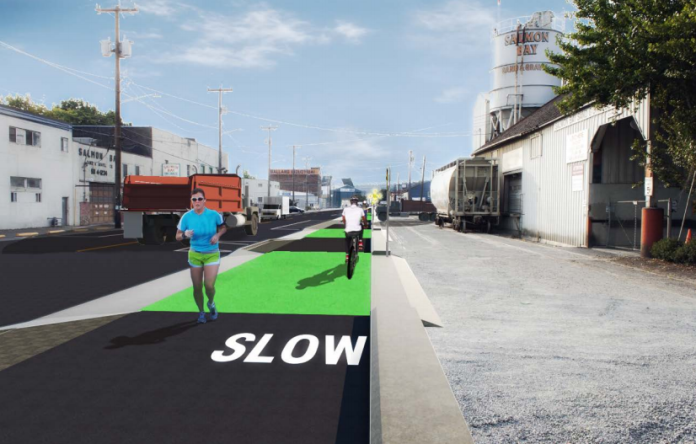The Seattle Department of Transportation (SDOT) revealed its 60% designs for the Missing Link portion of the Burke-Gillman Trail yesterday. The Missing Link is a gap in the multi-use trail between 11th Ave NW to 30th Ave NW (downtown Ballard) that shunts bicyclists onto busy Shilshole Ave NW. This arrangement has led to many collisions that resulted in serious injuries and deaths.
A plan has been in the works for decades and subjected to a dizzying array of Seattle process, but light is finally emerging at the end of the tunnel as the design crosses the 60% design hurdle. The South Shilshole alignment is SDOT’s preferred alternative and a clear favorite for most stakeholders. If that wasn’t enough, SDOT succinctly laid out the case.
- “Most direct, shortest, flattest and fastest route through Ballard;”
- “Route used most often by cyclists and pedestrians to get to the existing Burke-Gilman Trail, and would likely remain used if another route selected;”
- “Least number of roadway intersection crossings;”
- “Least number of rail crossings, which are notoriously dangerous for cyclists and rail operators;”
- “Least impact on, or need to modify, existing driveways or loading docks.”
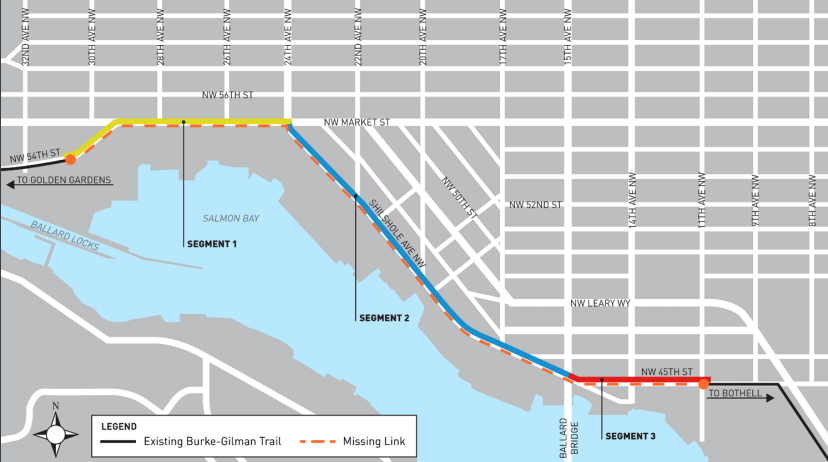
Segment 1: Market Street Road Diet
An encouraging sign is the inclusion of broader safety improvements on Market Street that will benefit all street users. A four to three lane road rechannelization (a.k.a. road diet) would not only create space for the protected multi-use facility, but also encourage lower speeds and safer turning and passing maneuvers at the messy intersection with 24th Ave NW.
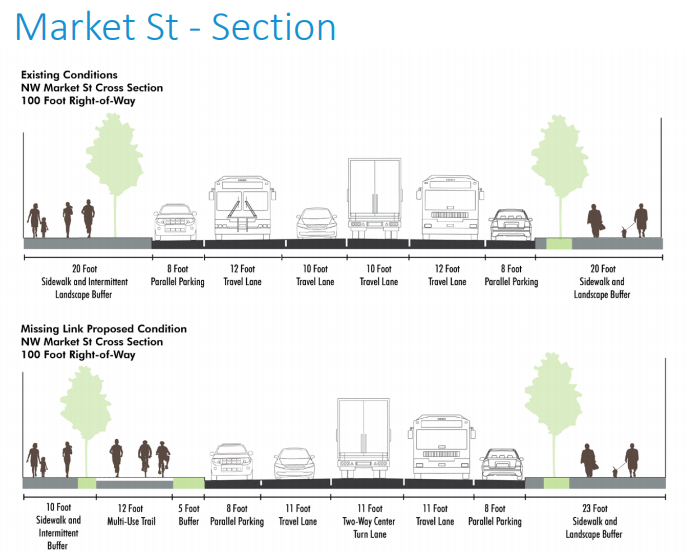
SDOT offered some data that builds a compelling case that rechannelizations both improve safety and improve flow. Notice Fauntleroy Way SW and N 130th St which saw injury collisions drop by more than 70%. Nickerson Street saw “aggressive speeding” drop 93% following a rechannelization and Stone Way N saw a 75% drop. Rechannelization could broaden the impact of Missing Link project to make Market Street a safe “Complete Street” in the redesigned segment.
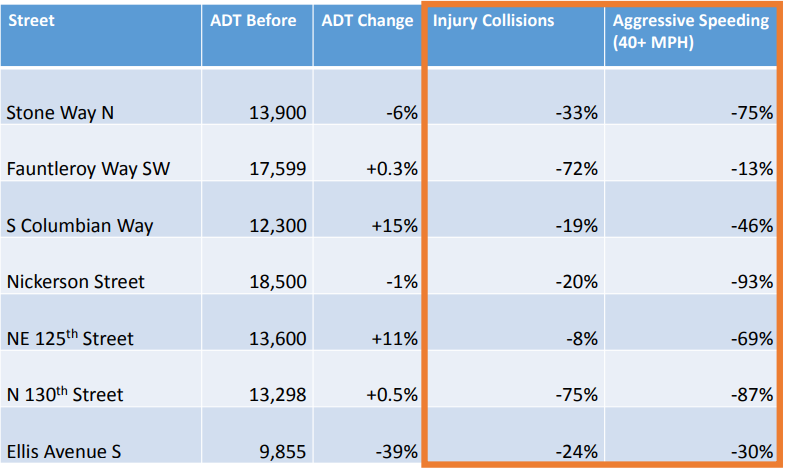
Segment 2: South Shilshole Multi-Use Trail
On Shilshole, SDOT would find room to continue the mixed-trail by replacing the informal walking path on the south side of the road and reducing the lane widths from the existing 12 feet to 11-foot lanes. Parking is maintained on the north side, but is slimmed down from 22-foot back-in parking to 17-foot back-angle parking. This should also make parking maneuvers less dangerous since turning from 90 degrees is a slower and more cumbersome movement.
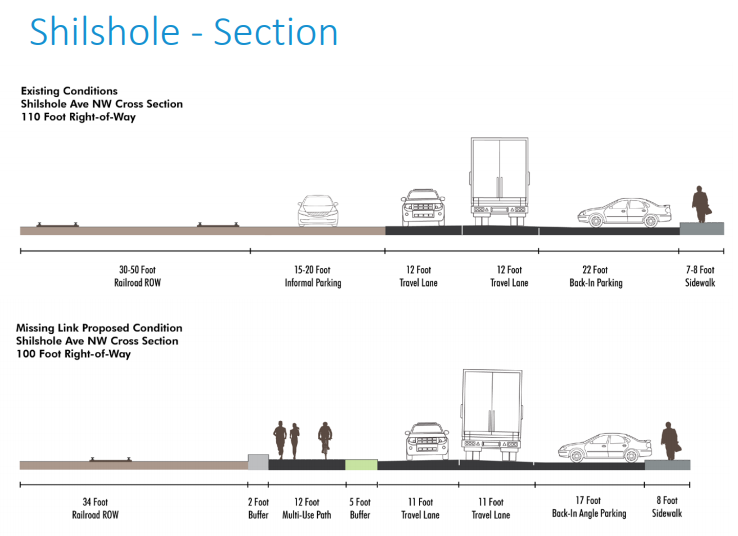
Segment 3: Multi-Use Side Path on Two-Way NW 45th St
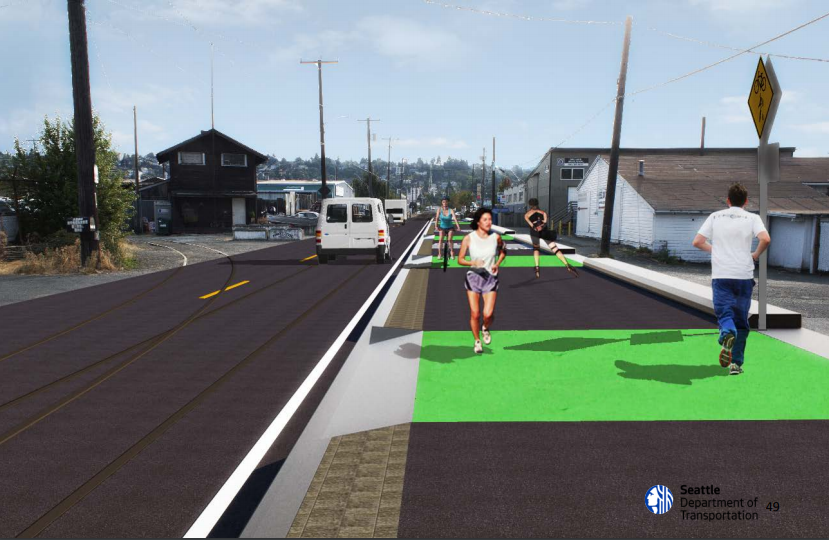
On segment three, SDOT would convert NW 45th St to two-way service from its existing one-way service in the segment. The north side facility is switched to the south side, saving at awkward crossing at 11th Ave NW where the Burke-Gilman goes from the sidewalk on the south side to a north-side two-way flex-post-protected bike lane, requiring trail users cross several lanes of traffic at a fairly busy four-way stop. Being on the south side of the street allows a smooth transition to the south-side facility on Shilshole. The design rendering suggests posts won’t be used, but curbs should provide some intermittent protection. Hopefully, trail users feel sufficiently protected.
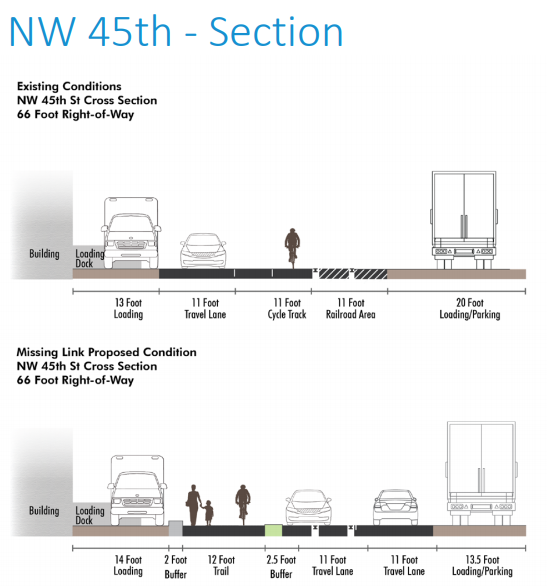
SDOT plans to add a westbound lane for cars where none exists today by reclaiming space from dormant railroad right-of-way and taking a few feet from parking/loading area. So, don’t say cars don’t get anything from this project.
Political Support and State Sen. Reuven Carlyle
After so many years of consensus building, one might be tempted to say the Missing Link had earned widespread support and seems a shoe-in. But then Ballard’s State Senator Reuven Carlyle took a joy ride on his motorcycle to ponder some deep thoughts and he published those concerns on his blog, casting doubt on the hard-fought political compromise in the name of yet more bargaining and fiscal conservatism, apparently. (Readers may recall State Sen. Carlyle voted for the $4 billion viaduct replacement tunnel for SR-99 in 2009.)
A Seattle Times editorial in June of 2017 outlined the issue thoroughly, and called for a negotiated settlement between the parties and the city. I cannot stress how much I agree with this approach and would amplify the frustration that years and millions continue to be wasted with virtually no anticipated success for anyone.
When pressed, State Sen. Carlyle said he wasn’t advocating for a particular route–though The Seattle Times article he endorsed advocated for a routing on Leary Way that SDOT’s study suggested would be more circuitous and dangerous for cyclists (since it required crossing several busy streets). Whatever political games he’s playing with the Missing Link in the eleventh hour, part of the responsibility for how long projects like this take lies with state legislators. Lawmakers could pass laws laying out a saner framework for legal challenges under the State Environmental Protection Act (SEPA) and they could even categorically exempt small walking and biking trails. But they haven’t, at least for these types of projects.
If Carlyle read more than SeaTimes editorials, he might know 90% supported South Shilshole Alt in public outreach. https://t.co/J4jXhZrKej
— The Urbanist (@UrbanistOrg) October 5, 2017
State Sen Carlyle doesn’t seem to comprehend the concern of safety advocates. “Bicyclists want a contiguous recreational experience,” he wrote. That’s quite the understatement. Trail users want much more than recreation. They want to avoid death or serious injury while using the road. An improved trail could save lives, get more people safely to their jobs, and boost the local economy, just as freight investments could help the economy.
Moreover, the compromise the Seattle Times Editorial Board and their convert Carlyle want to renegotiate in the eighteenth year has already been hammered out. The trail jogs over Market Street to reduce impacts on freight. A signalized crossing of Shilshole Ave NW to reach Leary Way would have impacts on freight in its own right. The compromise is here, and frankly it looks pretty dang good. It’s hard not see to see newfound reservations published at the 60% design phase as much more than political posturing.
For more information, check out the newly released design packet. The City’s project website states “final design and permitting are expected to be complete by early 2018, with construction beginning soon after. The project is anticipated to be complete in 2019.”
Doug Trumm is publisher of The Urbanist. An Urbanist writer since 2015, he dreams of pedestrian streets, bus lanes, and a mass-timber building spree to end our housing crisis. He graduated from the Evans School of Public Policy and Governance at the University of Washington in 2019. He lives in Seattle's Fremont neighborhood and loves to explore the city by foot and by bike.


